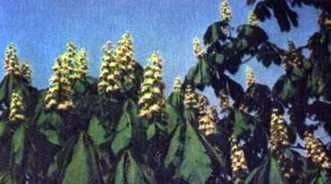
Among animals, as well as among people, there are sophisticated gourmands. But people have ample opportunities to satisfy their whims, whereas in animals nature has more strictly defined to each species what it can eat and what is not. Some insects are vegetarians, while others are bloodthirsty predators. The caterpillars of some butterflies feed on the leaves of various plant species, but there is a caterpillar that lives only on willow-bred and neglects other food, even if it is threatened with starvation.
These differences are amazing, because, in fact, all people and all animals (eating some particular food or omnivores) need the same nutrients. Only they introduce them into the body in several different forms. We all need fat and sugar – these are combustible substances for our living machine, the source of the strength of our muscles, they are just as necessary to us as fuel to a locomotive. However, this does not follow, as the children say, that we should eat only sweets.
Bread and potatoes are also sources of sugar for our body, because starch, their main constituent, is chemically close to sugar and our digestive organs process it into sugar. But we need a protein, because the human body (and animal) consists mainly of protein substances and can grow only if it receives protein from the food.
Bees also need these two kinds of nutrients. It is rare for anyone to meet such a clear division of food into two varieties. Bees collectors are looking for and bring to the shelter as separate elements of food rich in sugar and almost free of protein honey, which supplies the body of the bee with heat and energy material, and flower pollen – an indispensable building material for the growing body.
Both bees are found in flowers, diligently swarming in the flower halo. Hungry mouths are many in winter, but there are no flowers at this time. Therefore, in the spring and summer months, when everything is blooming and gives a rich “bribe”, bees collect the excess of honey that is consumed in the winter. The upbringing of young bees, whose growing body needs protein, is limited to spring and summer months. That is why bees store pollen in such quantity that there were no breaks in a delivery of brood in those weeks when there is no arrival of fresh pollen in a hive.
What is honey and how are bees collected?
After tearing off the head of the clover clover and carefully pulling out several separate flowers from it, and then chewing on their lower, tubular-shaped ends, we clearly feel the sweet taste. If the bees have not yet emptied our flowers, then at the end of the flower tube we will notice a small transparent drop – this is sugar syrup. Most flowers give off such a sugary juice in the depths of their flower bases.
Botany call it nectar – and rightly so. So the ancient Greeks called the drink of the gods. He possessed an amazing aroma and granted immortality. Honey, undoubtedly, also has a pleasant aroma. True, it does not impart immortality, but many beekeepers of old age-like some doctors-are firmly convinced that honey is good for health and prolongs life. Is it really so, and if so, why, – scientists have yet to explore.
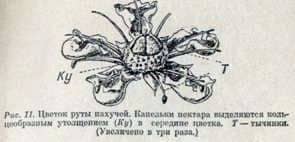
In some flowers, droplets of nectar lie openly at the base of the petals of the unfolded corolla, and not only bees, but also flies, beetles, and other gourmets from the insect world visit them.

In other flowers, such as clover or a flower of thermopsis, the nectar stands out at the bottom of the deep corolla tubes, from which only insects, supplied by nature with a special device, can reach: a beetle, a bumblebee and butterflies rise above the oral opening; see Figure 7), with which they can suck in sugary juice, even from deep corolla tubes.

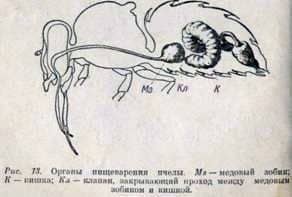
Everything that gets into our stomach is digested and, undoubtedly, belongs only to us. But the stomach (honey beet) bees can be compared with a shopping bag, the contents of which belong to the whole family – all members of the bee family. When you visit the flowers, droplets of nectar one by one flow through the proboscis and the long esophagus into honey cinders. If the bee is hungry, it slightly opens the valve, which separates the “public stomach” from the gut entering into it. Only that which penetrates into it is digested by the bee and goes to satisfy the needs of its own organism.
Most of the contents of honey crab, the bee, returning to the hive, regurgitates, and this serves the satisfaction of the needs of the entire community. To say that bees collect honey is not entirely correct.
They collect nectar and make honey out of it. Freshly brought nectar gatherers distribute their numerous hive friends, and they repeatedly spit this little drop and hold it in front of the mouth in the warm air of the hive; As a result, a lot of water evaporates from it, and then it thickens in an open cell. So for a few days of liquid nectar, half-finished honey is obtained. At the same time, the secrets of the glands of bees are acting, thanks to which the sugar partially passes into a more easily digestible form – just as it does in our stomach. Bees seem to free our stomach from digesting this product.
In addition, honey (apparently, thanks to the barely visible traces of some as yet undiscovered substances that are produced by the flowers or the body of a bee) is also highly valued as a food product. So from the sweet juice of flowers the bees prepare unburnt and useful honey. But do not forget that the source of sugar is nectar, and the aroma of honey is the smell of flowers, perceived by nectar, to which the smell of bees and wax itself was added.
So, flowers are the main producers of this refined food product; bees we owe it to the improvement and the fact that the honey entered our menu: human patience would not be enough to collect from flowers the tiny droplets of nectar.
The amount of nectar that a bee brings home as a result of one flight for a bribe is small, but indeed its honey cindicus is little more than a pinhead, and it has to pour and empty it 60 times to collect a thimble of honey. And a drop of nectar, which offers her every single flower, is even less; to fill the honey zobik, our collector has to visit not less than 1000-1500 flowers of clover. If, in spite of this, some bee colonies in favorable periods store for one day more than one kilogram of honey, this only proves how hard they work. And let the gourmet, swallowing a spoonful of honey with the same ease as a spoonful of milk, sometimes think about how hard it was extracted.
Flower pollen and “panties” of bees
Flower pollen is easier to notice in flowers than a deeply hidden drop of nectar. It produces anthers of stamens (it is called pollen for its resemblance to dust). In each flower, depending on the type of plant, there is a certain number of stamens that rise from the base of the flower with delicate threads and thicken on the upper free end into a small pad. Here, in most flowers, pollen is formed in the form of a yellowish, whitish or reddish powder, often in such abundance that it is only necessary to touch the flower with a finger, so that it is covered with it as a powder. From the stamens of the bee and take the pollen.
This, as a rule, is not the kind of worker bees that collect nectar. As in the modern factory, the “workshop” is widely used “division of labor,” so that even among the pickers feed only fly for honey, others only for pollen and everyone is busy with their own business. And collecting pollen is far from easy. Even the most skilled juggler would envy the dexterity of small bee-legs.
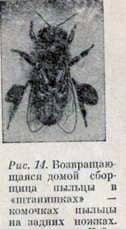
The bee – the pollen collector does not swallow it like nectar, but, according to the expression of the beekeepers, collects it in an update, that is, rolls into pieces, glues it from the outside to the back legs and in these “panties”, which probably everyone saw, comes back home. The process of collecting pollen takes place with such incredibly fast movements that it is hardly possible to trace them with the eye. To study this process, it took some ingenuity.

Good work requires good tools – they have a working bee from birth. In Fig. 15 shows the location of the legs on her body. They, like the legs of other insects, consist of separate joints joined by joints; We are most interested in the largest – the thigh, the shin and the foot, which in turn consist of many segments.
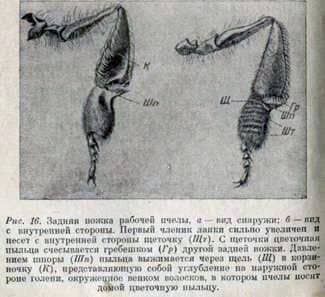
On the hind legs, which play a special role in the collection of pollen, the first segment of the foot is greatly enlarged and enlarged, and its inner side is covered with hard bristles – the “brush”. The leg of the hind leg is also arranged in a special way. On the outside, it has a smooth and partly slightly concave surface, bounded by long hairs, a “basket”. In the baskets the bee brings home a bundle of pollen. And they get there so.
Each bee, going to fly for the pollen, takes a little honey from the house in honey cinders. On the flowers, it sits on the stamens (especially well it can be observed on large flowers of poppy or rosehip) and it is accepted to scratch the pollen from them with jaws and forepaws while wetting it with honey brought with it so that the pollen becomes sticky. If there is a lot of pollen, it thickens all the hairs of the body of the bee during its work on the flower and the bee sometimes seems sprinkled with flour.
During the flight of the bee from one flower to the other, its legs are occupied with feverish work: by brushing the hind legs, it cleans the pollen from the surface of its body and from other legs, then with a crest of solid bristles, located at the end of the shin Fig. 16, Gr), combs the pollen from the breast and other legs, alternately with the right and then the left. Now the pollen hangs on the crest, but only for a moment. With the nimble pressure of the spur, she is pushed through the gap to the other outer side of the shin, that is, falls into the basket. Here, she pushes for push from below, panties increase and rise higher, until the whole basket is full. After that, the middle legs tighten the lump and beat on it from the outside so that it fits well and is not lost on the way.
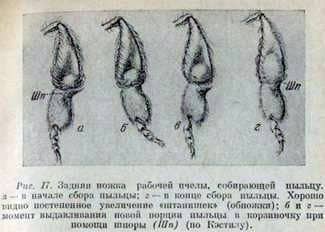
Returning home, the picker shakes the panties in the cell. And now a young bee, busy inside the hive works, thrusts his head there, splits both pollen lumps with jaws extended forward and jerks the pressed down pollen, combining it with the old stores in the cell. (She reminds the hostess, ramming cabbage with fermentation.)
Bees never mix honey and pollen stocks, but store both types of food in separate cells of the honeycomb and take them out from there as needed.
What is the use of flowers because the bees take them off?
Bees have to be judged for extracting nectar and pollen from flowers. And if flowers offer them these two kinds of food, then it benefits the very same colors.
Pollen grains are male germ cells of flowering plants corresponding to the spermatozoa of animals. Female sex cells, corresponding to the ovum animals, often – though not always – are formed on the same flowers that produce pollen. They lie in a special thickening of the base of the flower – the so-called ovary.
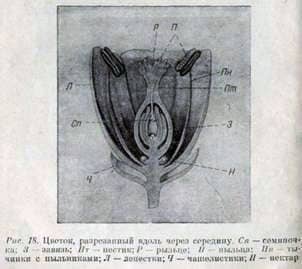
Just as from a chicken egg the chicken will develop only if the egg has been fertilized with the sperm of the cock, and in the ovary of the flower from the female germ cells the seeds will develop, and then the young plants will only grow if the female sex cells merge with the male.
For fertilization of germ cells, it is necessary that some amount of pollen get on the sticky stigma of the pistil, that is, the flower should be pollinated. From the stigma the contents of the pollen grains with sprouted pollen tubes through the pistil (P) get into the ovary and merge with the female sex cell. If the pollen does not fall on the stigma, then there will be no fruit.
But the flowers, as a rule, can not themselves pour the pollen from the anthers on the stigma, since the stamens are not capable of arbitrary movements. In addition, the plant is not at all profitable if the pollen falls on the stigma of the pistil of the same flower – closely related crossing, as well as in animals, can be harmful. A healthier offspring is formed if the pollen falls on other flowers of the same species. There are many tools that contribute to this. Often the flowers are completely unresponsive to pollen, which they themselves produce, so that during self-fertilization they remain infertile.
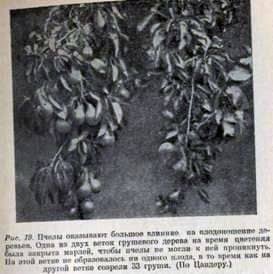
When a bee collects pollen, flies from poppy to poppy or from rose to rose, it carries the pollen from the flower to the flower. Covered with pollen, like a miller with flour, the bee inevitably drops some pollen grains on the stigma of the pistil, thus pollinating the flower. But the bees of nectar gatherers touch the anthers and stigmas, trying to get the sweet juice at the base of the flower, and unconsciously fulfill the duties of breeders. Photo better than words proves how successful they are with them. On one pear tree, for example, before blossoming, two branches with the same number of buds were chosen. One of them was covered with gauze so that the bees could not penetrate to the flowers. From the flowers on the branch, which was available to the bees, 33 pears developed, on the other branch no fruit was formed.
Other insects can also be pollinators of flowers. On a sunny spring day you can observe a motley swarm of bumblebees, butterflies, beetles and flies curling around flowers. But the most important carriers of pollen are still bees, because they are very numerous, very zealous in collecting pollen and nectar, and also because they are motivated not by the transitory feeling of hunger, but by the desire to store food for the winter. In addition, having a good device for collecting nectar, they are able to visit many flowers that other insects less suitable for this use can not. If not bees, not only many of our fruit trees, but also clover and buckwheat, beans and cucumbers, blueberries and lingonberries, countless meadow flowers and other vegetation would not give or give very few fruits and seeds at all.
But today’s fruits are future plants. Of seeds, the next generation grows, and plants that do not bring in seeds or bring them very little die out. Selecting nectar, flowers attract insects; the latter find bait and also take away excess of pollen. But they can not be considered robbers: they not only take, but also give, producing pollination, providing the formation of seeds and supporting the life of the species. Excellent mutual assistance, the more amazing that both sides and do not suspect what they are doing!
Уксус для пчел. Рецепт пыльцы.
The bee family and its composition